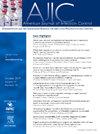Long-lasting effects of control measures on trends in incidence in neonatal late-onset sepsis due to multiresistant bacteria in a Brazilian neonatal unit
IF 3.8
3区 医学
Q2 INFECTIOUS DISEASES
引用次数: 0
Abstract
Background
In response to a 1995 outbreak of sepsis caused by multidrug-resistant (MR) Gram-negative bacteria (GNB), a Brazilian level III neonatal unit established a series of control and prevention measures. This study evaluated the long-term effects of these measures on late-onset neonatal sepsis (LONS) caused by MR bacteria from 2000 to 2020 and examined their impact on in-hospital mortality.
Methods
Newborns with LONS and positive cultures for Staphylococcus aureus, GNB, and Enterococcus sp were selected, adhering to Center for Desease Control and Prevention and local criteria. Joinpoint regression analysis was used to assess annual trends.
Results
Over the 21-year period, the overall LONS rate was 4.6%, showing a significant decline from 2000 to 2016 (P < .0001, slope -0.36). However, from 2016 to 2020, there was a non-significant increase in sepsis rates (slope +0.92, P = .08). MR sepsis were in 15.8% of sepsis cases and displayed a non-significant upward trend (slope +0.50, P = .08) with no major shifts. In-hospital mortality rates for MR and non-MR LONS showed no significant differences (P = .413).
Discussion
The study indicates a low prevalence of MR sepsis due to effective antimicrobial use and educational interventions.
Conclusions
MR sepsis prevalence remained low and stable, not increasing in-hospital mortality.
巴西新生儿病房多重耐药菌引起的新生儿晚期败血症发病率趋势的长期控制措施效果。
背景:1995 年,由于爆发了由多重耐药革兰氏阴性菌(GNB)引起的败血症,我们的新生儿科制定了一系列控制和预防措施。本研究评估了这些措施在 2000 年至 2020 年期间对巴西一家三级新生儿科内由多重耐药菌引起的迟发型新生儿败血症(LONS)的长期影响,并研究了其与院内死亡之间的关系:分析了由金黄色葡萄球菌、GNB 和肠球菌引起的经血液和/或脑脊液培养阳性证实的 LONS 新生儿。MR标准遵循美国疾病预防控制中心和当地传染病指南。采用连接点回归分析法对每年的败血症趋势进行了评估:21年间,确诊的LONS率为4.6%,从2000年到2016年出现了显著下降(P 讨论):研究表明,由于抗菌药物的有效使用和教育干预措施,MR 败血症的发病率较低:结论:MR 败血症的发病率仍然较低且稳定,不会增加院内死亡率。
本文章由计算机程序翻译,如有差异,请以英文原文为准。
求助全文
约1分钟内获得全文
求助全文
来源期刊
CiteScore
7.40
自引率
4.10%
发文量
479
审稿时长
24 days
期刊介绍:
AJIC covers key topics and issues in infection control and epidemiology. Infection control professionals, including physicians, nurses, and epidemiologists, rely on AJIC for peer-reviewed articles covering clinical topics as well as original research. As the official publication of the Association for Professionals in Infection Control and Epidemiology (APIC)

 求助内容:
求助内容: 应助结果提醒方式:
应助结果提醒方式:


